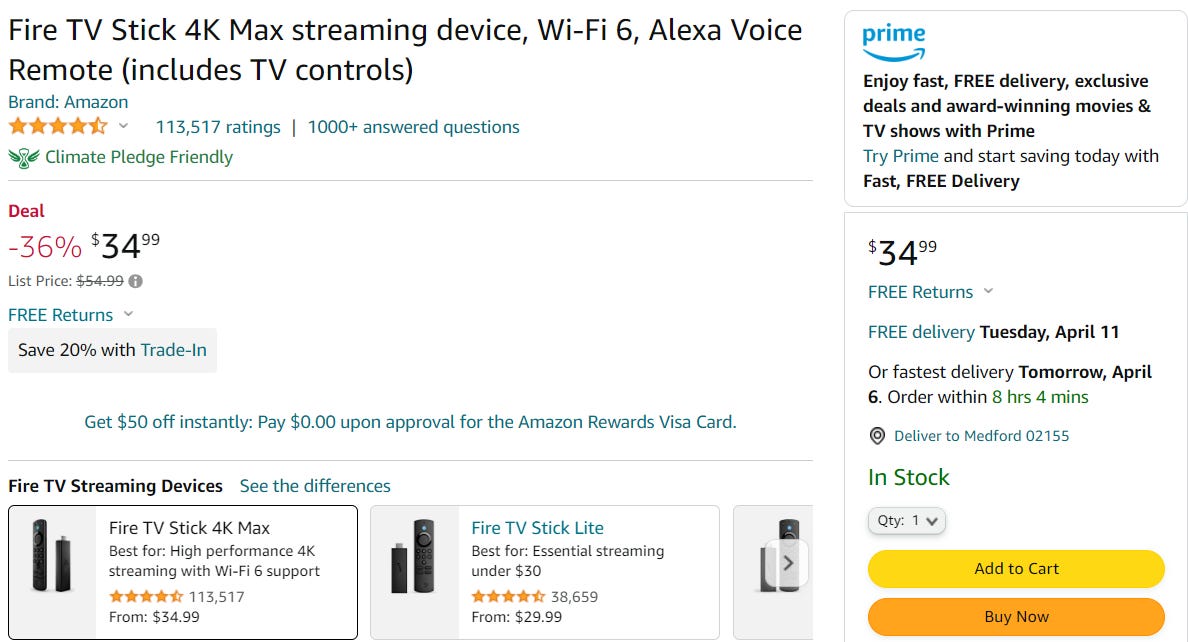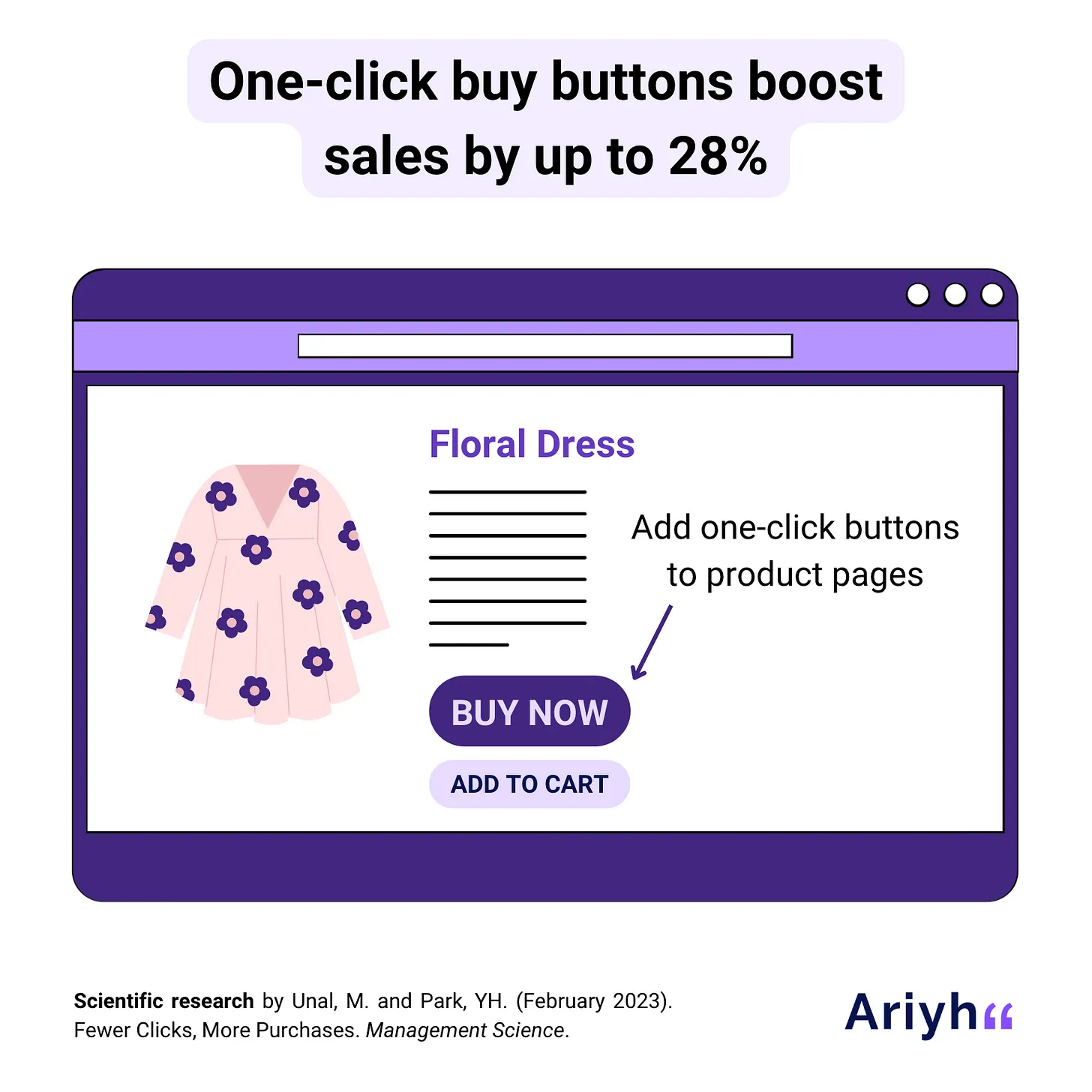by THOMAS MCKINLAY for Aryih
Almost 70% of items people place into their online carts are abandoned and never bought (according to Baymard Institute, 2022).
The top reason is a long and complicated customer check-out.
So what happens when you simplify it to the max?
Enter: One-click buying.
Here are the effects, according to scientific research from Cornell and Amazon.
Previous insight: Boost conversions with more white space (more insights here)
One-click buy buttons boost sales without increasing returns
Channels: Ecommerce | Customer experience | Website | Customer journey | UX | UI
For: B2C. Can be tested for B2B
Research date: February 2023
📈 Recommendation
Use one-click “Buy now” buttons in your online store, (alongside the standard “Add to cart” option).
These buttons let your customers order a product without having to re-enter billing and shipping information or visit a checkout page.
People will spend more at your online store, buy more items and spend more time on your site, visiting more pages each visit.

Pro tip: You can also increase total sales by a further 28% by adding quantity options to different call-to-action (CTA) buttons, such as “Buy 1” vs “Buy 2”.
🎓 Findings
- One-click buttons increase numbers of items bought, spending per month, website visits, and time spent on site.
- Researchers analyzed 35 months of data from over 18,000 online shoppers of an anonymous Asian retailer after it introduced one-click buying. They found that customers that switched to one-click buying:
- Spent an average of 28.5% more ($5.7 per month) after switching to one-click buying
- Placed 43% more orders and bought 36% more items
- Made 32 more visits to the site and spent 245 more minutes on site
- One-click buying did not reduce offline sales or increase product returns.
🧠 Why it works
- When we navigate checkout pages we may go through different emotions. Sometimes they’re positive (e.g. anticipation, happiness), but often they’re negative (e.g. frustration, anger). These influence how satisfied we feel and how much we engage with the company.
- One-click buying saves us from having to go through checkout, and re-enter information for each purchase, which improves our experience with the website and makes us more engaged.
✋ Limitations
- The research analyzed a single Asian retailer. The company asked to remain anonymous. They specialize in clothing, shoes, and personal care products. The findings may not apply 1:1 to other companies.
- The company is a marketplace-style retailer (e.g. Amazon or Taobao) so the effect may be different – or not exists – for company websites selling their own brand.
- The retailer introduced the functionality in January 2017, the same year Amazon lost its patent on the functionality. Since then, many more companies have adopted it. It’s unclear if the impact remains the same now that it’s more common.
- One-click buying relies on information saved by customers on previous purchases. People probably don’t save their information when buying from brands or websites that they don’t buy from often, so this technique unlikely to work in such cases
🏢 Companies using this
- Amazon introduced one-click buying in 1997, with an exclusive patent on the technology that expired in 2017. Estimates valued the patent at $2.4 billion annually because of its impact on sales.
- Since the patent expired, other companies have adopted one-click pay technology, including Apple Pay, Paypal, and Fintech companies such as Affirm and Klarna.
- Beyond marketplaces, individual companies are also using one-click buying on their own sites, including:
- GNC’s integration of one-click buying through Paypal, Apple Pay and Klarna.
- Revolution Beauty offering one-click buying with Apple Pay
Amazon’s “Buy Now” button prevents shoppers from having to re-enter shipping and billing information. Those still browsing can use the standard “Add to Cart” option.

⚡ Steps to implement
- Add an option to one-click buy to your product pages. This can use text such as “Buy now” or “Buy in one click”. Make sure it’s clear it’s a one-click purchase. You may want to show the customer’s delivery address near the button, for reassurance.
- When customers buy from you for the first time, encourage them to create an account and save their information.
- The next time they visit, assuming they are logged in (if not, make it an easy step to do), they will be able to buy using the one-click button.
- You can further optimize this by integrating with other payment solutions such as Apple Pay, Google Pay, or Paypal. These save customers from saving credit card information with you, making it more likely that they will create an account and activate one-click buying.
🔍 Study type
Market observation (of 18,206 customers of an Asian online retailer between January 2016 and November 2018)
📖 Research
Fewer Clicks, More Purchases. Management Science (February 2023)
🏫 Researchers
- Murat Unal. Amazon.com
- Young-Hoon Park. S.C. Johnson School of Management, Cornell University
Remember: This is a new scientific discovery. In the future it will probably be better understood and could even be proven wrong (that’s how science works). It may also not be generalizable to your situation. If it’s a risky change, always test it on a small scale before rolling it out widely.
